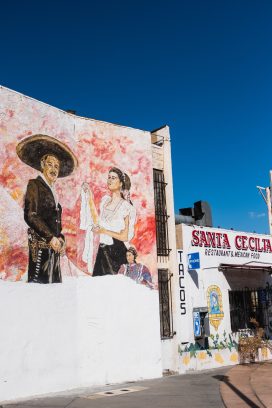On an exterior wall on the southwest corner of Soto Street and E. Cesar Chavez Avenue, the mural “El corrido de Boyle Heights” (“The Ballad of Boyle Heights”) depicts neighborhood musicians, a singing woman and dancing newlyweds.
Painted in 1983 by the East Los Streetscrapers, a collaborative public art studio co-founded by Wayne Alaniz Healy, the mural shows local musician Margarito Gutierrez playing a fiddle, while El Piporro, a famous Mexican actor, singer and songwriter, plays an accordion. According to the Los Angeles Mural Conservancy, it is at the least the third mural to occupy the same wall.

While the mural serves as an homage and entrance to the community, it has been severely damaged over the years, even after being restored by the Los Angeles Mural Conservancy in 1990.
Los Angeles was once known as the city of more than 1,000 murals, but experts estimate that 60 percent have vanished, and more have been defaced. Over the years, some murals around Boyle Heights have been tagged or whitewashed. Many of the murals depicted the 1960s movement for Chicano equality.
While there have been efforts to restore some murals, few have succeeded. One successful effort restored Healy’s mural in Ramona Gardens, “Ghosts of the Barrio,” painted in 1974.
Healy says the City of Los Angeles commissioned the J. Paul Getty Museum to restore it in 1999, and five or six women came in with lab coats and brushes. “It felt pretty nice to have them come in, take our humble mural and clean it up,” he says.
The California Art Preservation Act authorizes civil penalties for vandalism or destruction of artists’ work and allows artists to sue for damages and attorney fees from anyone who alters, mutilates or destroys one of their artworks.
Artists and historians fear that the community no longer values the murals and that this important part of Chicano history could be lost to future generations.
“The murals are being destroyed because they say the truth about who we are,” says Ernesto de la Loza, a muralist for over 50 years who lives in Echo Park. Of the 43 murals he has painted, only 11 have survived.
One of his most well known murals, the “Resurrection of the Green Planet,” is located on Cesar Chavez Avenue and Breed Street. The mural, which has been severely vandalized, portrays the preservation and protection of the earth.De la Loza says his purpose for creating murals such as “City of Passion,” located on West Boulevard, was to empower youth. He was born in Boyle Heights and traveled to Europe in the early 1970s. Upon his return, he used his murals to encourage people to learn about their history. “This is our culture,” he says. “I came back and did what I did to honor our great history, which schools weren’t teaching us.”
Sergio Daniel Robleto, a high school art instructor and artist who painted the “Santa Cecilia” mural in Mariachi Plaza, has had several of his murals severely damaged. “There are a few factors,” he says. “So much time has passed that the imagery within the piece maybe is no longer relevant, or it’s faded to the point that people don’t even know what’s really there.”

Robleto says that defacing murals is disrespectful, but that artists also have a responsibility to touch up or fix their work.
Isabel Rojas Williams, former director of the Los Angeles Mural Conservancy and a mural expert, says murals might be being vandalized because “not many people today think murals have a meaning to them. [Some] people do not want history to be portrayed.”
She says the destruction of murals has a bigger impact than just losing the paintings.
“Murals are a form of art that can make people have certain feelings,” she says. “If this continues happening, much of our history will stop being represented through different forms. I think that teens and youth should take action to keep these murals, as this is what we are.”

